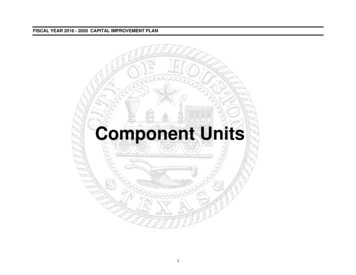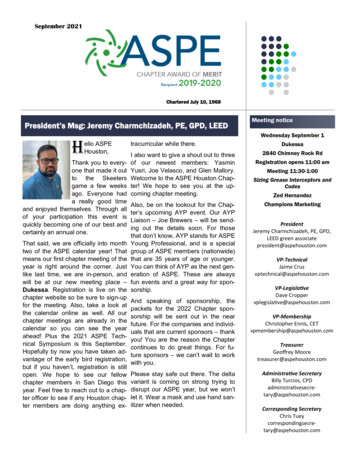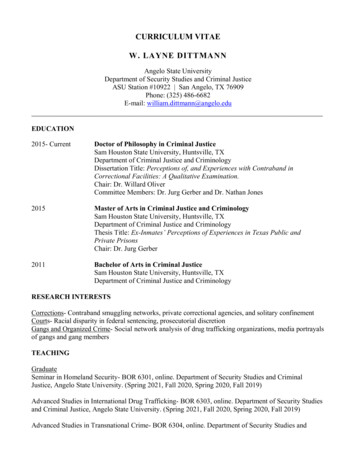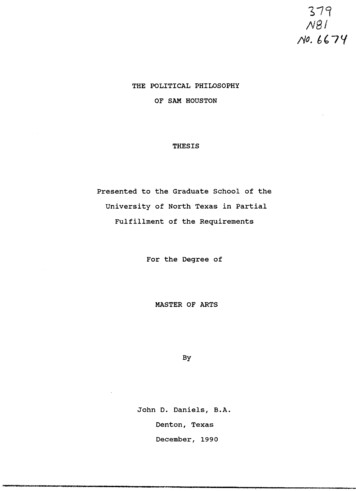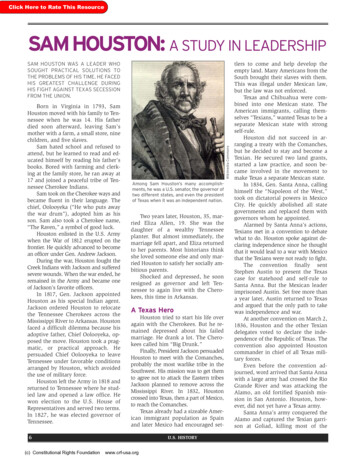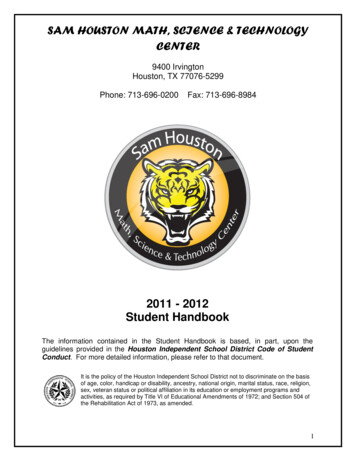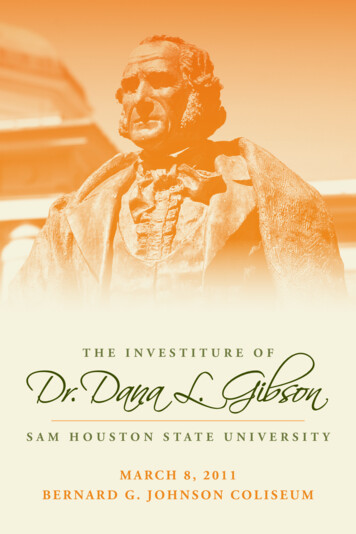
Transcription
THE INVESTITURE OFDr. Dana L. GibsonS A M H O U S TO N S TAT E U N I V E R S I T YMARCH 8, 2011BERNARD G. JOHNSON COLISEUM
Dr. Dana L. GibsonDr. Dana L. Gibson became Sam Houston State University’s 13th president onSeptember 1, 2010, following unanimous approval by The Texas State UniversitySystem. She is the first female president in the university’s history.Dr. Gibson is a product of the Texas educational system, growing up and attendingschools in north Texas. She also attended Texas universities, earning a Bachelor ofScience degree in business-accounting and a Master of Business Administration atTexas Woman’s University and a doctorate in business at the University of Texas atArlington.A Certified Public Accountant since 1984, Dr. Gibson began her career in privateindustry. In 1986 she joined academia when she was employed by Texas Woman’sUniversity as a lecturer in accounting and management information systems. Shewas promoted to assistant professor in 1989, and later received tenure as an associateprofessor of accounting and management information systems.In 1996, Dr. Gibson was named TWU’s special assistant to the vice president forfinance and administration. She was promoted to associate vice president for financeand administration and university controller and was named vice president foracademic and information services in 2000.She left Texas Woman’s University to become vice president for finance andadministration of the YMCA of Metropolitan Denver (Colorado). After serving twoyears, she was named vice chancellor for administration and finance at the Universityof Colorado at Denver (and Health Sciences Center) where she oversaw a budget ofmore than 700 million with funded research of 300 million.Dr. Gibson returned to Texas as the vice president for businessand finance at Southern Methodist University. Afterher service at SMU, she was selected as president ofNational University, the second largest not-for-profituniversity in California.In 2009, she joined Sam Houston State Universityas vice president for finance and operations. Herresponsibilities included the administrationof many of the business functions of theuniversity including the controller’s office,budget, auxiliary operations, procurement,property, public safety, parking, humanresources, facilities management, constructionand planning, information resources, andinstitutional research and assessment.
Investiture CeremonyM A RC H 8, 2011 3:0 0 P. M .BERNARD G. JOHNSON COLISEUMTrumpet Fanfare. SHSU Trumpeters“Bearkat” Fanfare by Michael DavisJonathon GregoryDavid HernandezRobby YarberJoey VranasJuan RiveraBrian FincherSteve LealEric WalleyProcessional. SHSU Orchestra - Dr. David Cole, ConductorCrown Imperial by William WaltonMace BearerPlatform PartyDelegates from Institutions of Higher LearningAdministration & Faculty of the UniversityPosting of the Colors. Sam Houston State University Army ROTC Color GuardNational Anthem. Mr. James Franklin, Song LeaderThe Star-Spangled Banner by Francis Scott Key/John Stafford SmithIntroductions and Reflections.Dr. Brian McCall, Master of Ceremonies &Chancellor, The Texas State University SystemWelcome. Dr. David Payne, Provost & Vice President for Academic Affairs
GreetingsMr. Ryan Bridges, President of Student Government AssociationMs. Kristie Kelarek, Chair of Staff CouncilDr. Mark Frank, Chair of Faculty SenateMr. Alan Tinsley, President of Alumni AssociationMs. Jane Monday, Community Leader & Former RegentSpecial Music.SHSU Orchestra and SHSU Chorale – Dr. David Cole, Conductor“The Promise of Living” from The Tender Land by Aaron CoplandIntroduction of Regent Charlie Amato.Dr. Brian McCallInstallation of the President. Mr. Charlie AmatoChairman of the Board of Regents,The Texas State University SystemAcceptance.Dr. Dana L. Gibson, PresidentHistory of the Presidential Medallion. Dr. Bobby K. Marks, President Emeritusand Introduction of Regent Trisha PollardPresentation of the Presidential Medallion. Ms. Trisha Pollard,Regent of The Texas State University SystemAlma Mater. Mr. James Franklin, Song LeaderAnonymous/Allen R. HightowerClosing Remarks. Dr. James F. Gaertner, President EmeritusRecessional.SHSU Orchestra – Dr. David Cole, Conductor“March Militaire Francaise” from Suite Algerienne by Camille Saint-Saëns“Trojan March” from Les Troyens by Hector Berlioz
D E L E G AT E SYale University. 1701Dr. Robert BlockerHenry and Lucy Moses Dean of MusicBaylor University. 1845Dr. Melinda HoltAlumnus, SHSU Associate Professor of StatisticsAustin College. 1849Dr. Ty CashionAlumnus, SHSU Professor of HistoryValparaiso University. 1859Mr. Nicholas SkytlandAlumnus, Director of the NASA Open Government InitiativeTrinity University. 1869Ms. Lee Adcock Hunnell, EsquireAlumnusPaul Quinn College. 1872Mr. Michael J. Myers IISpecial Assistant to the PresidentTexas Christian University. 1873Dr. Christopher WilsonAlumnus, SHSU Chair of Department of Psychology and PhilosophyTexas A&M University. 1876Dr. Pamela R. MatthewsAssociate Provost for Undergraduate StudiesUniversity of Colorado. 1876Dr. Brian BurnettVice Chancellor for Administration & FinanceSam Houston State University. 1879Dr. Janet MullingsAlumnus, SHSU Associate Dean of Criminal JusticeThe University of Texas at Austin. 1883Dr. Hugh MeredithAlumnus, Retired SHSU Professor of HumanitiesTexas A&M University-Commerce. 1889Dr. Stacey EdmonsonAlumnus, SHSU Chair of Department of Educational Leadership and CounselingUniversity of North Texas. 1890Dr. Rhonda CallawayAlumnus, SHSU Chair of Department of Political Science
Dr. Scott ChapmanAlumnus, SHSU Professor and Scholar in Residence of MathematicsTarleton State University. 1899Dr. Jane B. DennisAssociate Professor & Director, Academic Advising ServicesTexas Woman’s University. 1903Dr. Brenda FloydVice President for Finance and AdministrationWest Texas A&M University. 1910Dr. Gene YoungAlumnus, SHSU Director of Eliott T. Bowers Honors CollegeSouthern Methodist University. 1911Dr. Thomas E. BarryVice President for Executive AffairsDr. Brad E. ChevesVice President, Development and External AffairsRice University. 1912Dr. Stacy UlbigAlumnus, SHSU Associate Professor of Political ScienceEast Texas Baptist University. 1912Mr. George J. DayAssistant Professor of Criminal JusticeTexas Tech University. 1923Dr. Ronald DaigleAlumnus, SHSU Associate Professor of AccountingStephen F. Austin State University. 1923Dr. Archie McDonaldRegents Professor of History & Community LiaisonTexas Southern University. 1927Dr. Alice FisherAlumnus, SHSU Chair of Department of Health and KinesiologyUniversity of Houston. 1927Dr. Jim BexleyAlumnus, SHSU Professor of General Business and FinanceLamar State College – Orange. 1969Dr. Joe KirklandVice President for Academic AffairsLone Star College – Montgomery. 1992Dr. Austin A. LanePresidentUniversity of North Texas at Dallas. 2009Dr. John BeehlerProvost and Vice President for Academic Excellence and Student Success
Board of RegentsThe Texas State University System is governed by a nine-member Board of Regentsappointed by the governor. In addition, a nonvoting student regent is appointed annuallyto the board.Charlie Amato, Chairman, San AntonioDonna N. Williams, Vice Chairman, ArlingtonRon Blatchley, Regent, Bryan/College StationKevin J. Lilly, Regent, HoustonRon Mitchell, Regent, Horseshoe BayDavid Montagne, Regent, BeaumontTrisha Pollard, Regent, BellaireMichael Truncale, Regent, BeaumontChris Covo, Student Regent, San MarcosDr. Brian McCall, ChancellorPresident’s CabinetDana L. Gibson, PresidentDavid E. Payne, Provost and Vice President for Academic AffairsRandall Powell, Interim Vice President for Finance and OperationsFrank R. Holmes, Vice President for University AdvancementHeather Thielemann, Vice President for Enrollment ManagementFrank Parker, Vice President for Student ServicesTom Graf, Interim Vice President for Information TechnologyBobby Williams, Jr., Athletic DirectorKathy Gilcrease, Assistant to the President for OperationsThe University Academic DeansMitchell Muehsam, Dean of the College of Business AdministrationVincent J. Webb, Dean of the College of Criminal JusticeGenevieve Brown, Dean of the College of EducationDana Nicolay, Interim Dean of the College of Fine Arts & Mass CommunicationJohn de Castro, Dean of the College of Humanities & Social SciencesJaimie Hebert, Dean of the College of SciencesKandi Tayebi, Associate Vice President for Academic Affairs and Dean of Graduate Studies
HistoryAlthough Texas escaped much of the destruction wreaked on the rest of the Confederacyduring the Civil War, its public school system remained badly underdeveloped, and educationreformers expressed anxiety about illiteracy rates among former slaves as well as among poorwhites. In 1878-1879, with the political tumult of Reconstruction subsiding, a representativeof the Peabody Education Fund visited Texas hoping to convince the state legislature toestablish a public institution to train school teachers. George Peabody, a wealthy cottonbroker and banker, had endowed the philanthropy with money and a mission to “encouragethe intellectual, moral, and industrial education of the destitute children of the SouthernStates.” The fund offered to help subsidize a state-controlled teacher training institution, andin 1879, the state legislature acted upon the suggestion, establishing in Walker County theSam Houston Normal Institute, named after a great Texas hero.The institute moved into buildings abandoned by Austin College. The state legislatureoffered free tuition, laundry, room, and board to select students willing to become publicschool teachers after graduation. They promised to teach one year for each year of assistancereceived. Under the direction of Principal Bernard Mellon, who reported to the state boardof education, the Sam Houston Normal Institute opened on October 10, 1879, with acurriculum composed of professional and pedagogy courses. Students were admitted on thebasis of competitive examinations and hailed from each senatorial district in the state. Thefirst commencement of May 1880 included thirty-seven graduates.Consistent with educational values emerging in the United States during the Progressive Era,the Sam Houston curriculum expanded in 1909 beyond teacher education to include homeeconomics, industrial training, and vocational agriculture. In 1911, the state legislatureestablished a board of regents to govern the Sam Houston Normal Institute and authorizeda four-year curriculum leading to a Bachelor of Arts (B.A.) degree. The first B.A. degree wasconferred in 1919. Taking into account the more diverse curriculum and broader role andscope, the board of regents in 1923 christened the institution Sam Houston State Teacher’sCollege.In 1935, Sam Houston went beyond its teacher training mission with the board of regentshad authorizing bachelor’s degrees in business administration. The bicentennial of Texasindependence in 1936 had also occasioned the establishment of the Sam Houston MemorialMuseum as an affiliate of Sam Houston State Teacher’s College, and the board of regentshad authorized a graduate program, which produced three Master of Arts degrees in 1937.Sam Houston’s president, Charles N. Shaver, then decided the curriculum also needed to beexpanded to accommodate the needs of students interested in pursuing postgraduate trainingin law, dentistry, and medicine, and in 1938-1939, he added advanced undergraduate coursesin biology, chemistry, physics, English, government, and history.At the end of World War II, Congress passed the G.I. Bill, making it financially easierfor veterans to enroll in college and as a result, student numbers climbed. Worried about
housing so many new students, Sam Houston acquired 837 acres of land formerly used asa prisoner-of-war camp for German POWs. “Country Campus,” as it became known, waslocated about ten miles north of Huntsville on Highway 19. Two years later, enrollmentreached 2,410 students, of whom more than 1,000 were veterans.In 1950, Harmon Lowman, who had been Sam Houston’s president since 1946, negotiateda deal to acquire a used, 1,075-ton refrigeration system. Installation of the unit andconstruction of the duct work necessary to make it operational consumed several years,but the project’s completion rendered Sam Houston the first and only fully air-conditionedcollege in the United States. Summer school enrollment immediately increased.In 1952, Sam Houston began to sponsor a Reserve Officer Training Corps (ROTC) unit.Because ROTC was mandatory, more than half of all male students were active in the program,which helped set the tone for campus social life. The broadening of Sam Houston’s missionalso produced changes in the profile of college graduates. In 1960, more than one quarter ofSam Houston students majored in fields other than teacher education. In 1964-1965, SamHouston State Teacher’s College experienced three changes that would significantly reshapeits future reputation. President Arleigh Templeton, who succeeded Harmon Lowman in1964, added research to faculty responsibilities. Additionally, in response to the Civil RightsAct of 1964, Sam Houston ended its eighty-three year-old policy of denying admission toAfrican-Americans. John Patrick, valedictorian of Huntsville’s Sam Houston High School,subsequently matriculated as Sam Houston’s first African-American student. Furthermore,the state legislature established on campus the Institute of Contemporary Corrections andBehavioral Sciences, whose criminal justice program was destined to generate nationalrecognition. Enrollment in 1964 reached 5,738 students, and Sam Houston no longerserved the monolithic mission of teacher education. Because the college offered nine degreesin twenty-seven subject areas, including four graduate degrees, the legislature designated itSam Houston State College. In 1969, when enrollment reached 8,594, with 350 facultymembers, the state legislature acted again, and Sam Houston State College became SamHouston State University.During the next four decades, under the leadership of Presidents Elliot T. Bowers, Martin J.Anisman, Bobby K. Marks, and James F. Gaertner, Sam Houston State University continuedto grow– in size, mission, and reputation. By the fall of 2010, when Dr. Dana Gibsongained the mantle of the president’s office, the university offered to its 17,200 plus studentsa total of seventy-nine undergraduate degree programs, fifty-four master’s degree programs,and doctoral programs in Criminal Justice, Educational Leadership, Counselor Education,Clinical Psychology, and Reading. The university had become, in the words of CBS Newsanchor Dan Rather, its most well-known alumnus, a gem in Texas higher education. “Forall the changes, for all the expansion of infrastructure, mission, and educational ambition,”Rather said, “people have been Sam Houston’s constant. The names and faces change, but thespirit they have brought to and taken away from Huntsville, Texas remains the same. Peopleare Sam Houston’s strength, and so long as that is true, the college I knew and that today’sstudents know will be, in the ways that matter most, one and the same.”
University SealSam Houston State University has adopted as its official seal a high-contrast image ofthe statue of General Sam Houston, which stands in front of Austin Hall on the northend of the campus Quadrangle. Bordering the image are the words "Sam Houston StateUniversity," two stars, and the year in which Sam Houston Normal Institute was founded-1879. The seal is used primarily for official, university events such as commencement.University MaceThe University Mace is symbolic of the authority of the Board of Regents, The Texas StateUniversity System, and the Office of the President of Sam Houston State University. Themace, used in academic convocations, is carried by the senior tenured faculty member ofthe University. The initial use of the University Mace at Sam Houston State University wassummer commencement on August 20, 1988.The walnut staff is bound in brass and has a hexagonal head with inlays of pecan denotingthe state tree and recessed brass medallions cast with designs for General Sam Houston,Austin Hall, Old Main, Bearkats, and the completion date of the mace. The walnut holderbase or stall is six-sided to match the mace head.The crown of the mace is a circular casting bearing the name of the University and the dateof establishment, 1879. The center of the circle contains the State of Texas state emblem,the Lone Star. Below the crown, the names of past University presidents and the dates ofservice are engraved on a brass collar.The University Mace was designed and hand crafted by the late Charles R. Jedlicka,Associate Professor of Industrial Technology, who retired in 1989.
Academic RegaliaCollege and university ceremonies are resplendent with color. One is likely to see almostevery color in the spectrum, representing scholarly achievement in many academic fields.Based upon the costumes worn at universities in the 14th and 15th centuries, today’sAmerican academic dress was standardized in 1895. It includes the familiar square mortarboard cap symbolizing the commitment of the scholar to a life building. It has a tasselwhich may be black or an appropriate color (e.g. gold for those with a doctoral degree,purple for law).Three styles of gowns and hoods represent bachelor’s, master’s and doctor’s degrees. Thebachelor’s gown usually has long pointed sleeves, while the master’s gown has a long crescent-shaped sleeve. The doctor’s has a very full, bell-shaped sleeve with three velvet bandsmatching the velvet facing of the gown opening. The velvet on the doctor’s gown often isthe color appropriate to the wearer’s field of study.Of the three styles of hoods, the doctor’s is naturally the most elaborate. All three hoods aremade of material to match the gowns and are lined in the official color of the institutionwhich conferred the degree, with a chevron used for a second color if needed. The coloredvelvet binding indicates the academic area in which the degree was received.Hood trim colors on doctoral regalia indicate the following fields:Maize—AgricultureWhite—Arts, Letters, HumanitiesDrab—Commerce, Accountancy, BusinessLilac—DentistryCopper—EconomicsLight Blue—EducationOrange—EngineeringBrown—Fine Arts, including urple—LawLemon—Library ScienceGreen—MedicinePink—MusicSea Foam Green—OptometrySilver Gray—Oratory (Speech)Olive Green—PharmacyBlue—PhilosophySage Green—Physical EducationPeacock Blue—Public Administration & Foreign ServiceSalmon Pink—Public HealthGolden Yellow—ScienceCream—Social ScienceCitron—Social WorkScarlet—TheologyGray—Veterinary ScienceApricot—Nursing
Presidential MedallionThe Presidential Medallion is wornas part of the president’s academicattire at ceremonial occasions such asCommencement and Convocations.The tradition of a presidential medallionat SHSU dates back to the university’sninth president, Elliott T. Bowers, whoserved as president from 1970 to 1989.The original medallion was cast torepresent the first official Sam HoustonState University seal, which featureda head-and-shoulders image of SamHouston centered on a round disc,with the words “Sam Houston StateUniversity 1879” in a circle around thedisc. The chain is worn around the neckand drapes across the chest and back.The medallion being worn by Dr. Gibsonfor the Investiture Ceremony is an updated design, generously funded by TSUS RegentTrisha Pollard and her husband, Randy. The focal point of the medallion is the officialUniversity Seal. The chain has twelve small plates with the engraved names of the formerpresidents and their tenure in office. The “SH” logo is engraved in two ovals leading to theUniversity Seal. The current university president, Dr. Dana Gibson, is named in the plateabove the medallion.S A M H O U S TO N S TAT E U N I V E R S I T Y P R E S I D E N T SBernard MallonHildreth H. SmithJoseph BaldwinHenry C. PritchettHarry F. EstillCharles N. ShaverHarmon L. LowmanArleigh B. TempletonElliott T. BowersMartin J. AnismanBobby K. MarksJames F. GaertnerOctober 10-21, 010
AcknowledgementsThe President wishes to thank the following individuals and departments for theirextraordinary work in planning, preparing for and orchestrating the Investiture events andthose community members not identified here who have provided assistance and services.INVESTITURE COMMITTEEJane Monday. Co-Chair, Community Leader & Former RegentRichard Eglsaer.Co-Chair, Associate ProvostDavid Payne.Provost and Vice President of Academic AffairsRandall Powell . Interim Vice President of Finance and OperationsHeather Thielemann.Vice President of Enrollment ManagementFrank Parker.Vice President of Student ServicesFrank Holmes.Vice President of University AdvancementJaimie Hebert. Dean, College of SciencesVince Webb.Dean, College of Criminal JusticeMitchell Muehsam. Dean, College of Business AdministrationGenevieve Brown.Dean, College of EducationJohn de Castro. Dean, College of Humanities and Social SciencesKeith Jenkins. Associate Professor of Business AdministrationKeri Rogers. Assistant Vice President of Academic AffairsMark Frank.Chair of Faculty SenateSergio Ruiz. Associate Professor of MusicKristie Kelarek.Chair of Staff CouncilKris Ruiz.Associate Vice President of Marketing and CommunicationsBruce Erickson.Director of CommunicationsKay Kay Davis. Assistant Vice President of Information ResourcesKevin Morris.Director of Public Safety ServicesEd Owens.Past President of the Alumni BoardDanny Pierce.Walker County JudgeMaggie Collum.Director of University EventsKathy Gilcrease. Assistant to the PresidentLynn Clopton.Administrative Coordinator, Operations
Alma MaterHail to Sam Houston, School we love best,Mighty in battle, True to the test.Bearkats so loyal, Ever we’ll be.Orange and white Will lead us to victory! Hail, Alma Mater Hats off to you,Ever you’ll find us Loyal and true;Firm and undaunted Ever we’ll be,Here’s to the school we loveHere’s a toast to thee.
A Member of The Texas State University System
In 1996, Dr. Gibson was named TWU's special assistant to the vice president for finance and administration. She was promoted to associate vice president for finance and administration and university controller and was named vice president for academic and information services in 2000.


